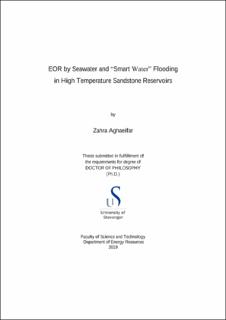| dc.contributor.advisor | Strand, Skule | |
| dc.contributor.advisor | Puntervold, Tina | |
| dc.contributor.author | Aghaeifar, Zahra | |
| dc.date.accessioned | 2020-04-20T08:03:30Z | |
| dc.date.available | 2020-04-20T08:03:30Z | |
| dc.date.issued | 2020-04 | |
| dc.identifier.citation | EOR by Seawater and “Smart Water” Flooding in High Temperature Sandstone Reservoirs by Zahra Aghaeifar. Stavanger : University of Stavanger, 2020 (PhD thesis UiS, no. 508) | en_US |
| dc.identifier.isbn | 978-82-7644-915-0 | |
| dc.identifier.issn | 1890-1387 | |
| dc.identifier.uri | https://hdl.handle.net/11250/2651613 | |
| dc.description.abstract | In the last decades, when the first treated injection water has resulted in incremental oil recovery, the activity to explore this technique has increased. And today, Smart Water flooding or low salinity flooding in sandstone reservoirs has been considered among the most promising choices to be implemented in some oil reservoirs, such as the western part of Norwegian Continental Shelf. The method has been widely thought-out considering both economic and environmental issues.
Offshore sandstone reservoirs are typically flooded with the most available surrounding water, which is seawater. So as main objective of this PhD it is questioned if seawater can act as a Smart Water? And if it is the case, what is the potential of low salinity EOR in tertiary mode. Due to the potential of scale precipitation and formation damage during seawater flooding, since fifty years ago removal of sulphate from seawater was considered by oil companies, and today from a Smart Water EOR perspective, it is also questioned if modified seawater could behave as Smart Water in the reservoir with incremental oil recovery as a result? And lastly, what injection strategy could be offered for high temperature offshore sandstone oil reservoirs?
To answer the oil companies' concerns above, four North Sea sandstone reservoirs, including the total number of 17 preserved core plugs with corresponding reservoir formation brine and stabilized reservoir crude oil, have been studied at each specific reservoir temperature. Reservoirs have a temperature above 100 °C and are investigated for different Smart Water EOR potentials. The reservoirs have different formation water salinity ranging from 23000 ppm up to 195000 ppm, and for each set of cores, specific injection brine salinities and compositions were tested and compared. | en_US |
| dc.language.iso | eng | en_US |
| dc.publisher | Stavanger: University of Stavanger | en_US |
| dc.relation.ispartofseries | PhD theses (TN-lER);508 | |
| dc.relation.haspart | Paper 1: Smart Water injection strategies for optimized EOR in a high temperature offshore oil reservoir”, Z. Aghaeifar, S. Strand, T. Puntervold, T. Austad. Journal of Petroleum Science and Engineering, June 2018, 165, pp 743-751. https://doi.org/10.1016/j.petrol.2018.02.021 | en_US |
| dc.relation.haspart | Paper 2 (Not in Brage) “Significance of Capillary Forces during Low-Rate Waterflooding”, Z. Aghaeifar, S. Strand, T. Austad, T. Puntervold. Energy Fuels, 2019, 33 (5), pp 4747–4754. https://doi.org/10.1021/acs.energyfuels.9b00023 | en_US |
| dc.relation.haspart | Paper 3 (Not in Brage): “Seawater as a Smart Water in Sandstone reservoirs?”, Iván D. Piñerez Torrijos, Zahra Aghaeifar, Tina Puntervold and Skule Strand. Manuscript submitted to SPE Reservoir Evaluation & Engineering journal, 2019. | en_US |
| dc.relation.haspart | Paper 4 (Not in Brage): “Low Salinity EOR Effects After Seawater Flooding In A High Temperature And High Salinity Offshore Sandstone Reservoir”, Z. Aghaeifar, T. Puntervold, S. Strand, T. Austad, B. Maghsoudi and J. C. Ferreira, SPE-191334-MS, SPE Norwegian One Day Seminar, Bergen, Norway, 2018. https://doi.org/10.2118/191334-MS | en_US |
| dc.relation.haspart | Paper 5 (Not in Brage): “Influence of Formation Water Salinity/Composition on the Low- Salinity Enhanced Oil Recovery Effect in High-Temperature Sandstone Reservoirs”, Z. Aghaeifar, S. Strand, T. Austad, T. Puntervold, H. Aksulu, K. Navratil, S. Storås, and D. Håmsø. Energy Fuels, 2015, 29 (8), pp 4747–4754. https://doi.org/10.1021/acs.energyfuels.5b01621 | en_US |
| dc.relation.haspart | Paper 6 (Not in Brage): “The role of kaolinite clay minerals in EOR by low salinity water injection”, T. Puntervold; A. Mamonov, Z. Aghaeifar, G. O. Frafjord, G. M. Moldestad, S. Strand, T. Austad. Energy Fuels, 2018, 32 (7), pp 7374–7382. https://doi.org/10.1021/acs.energyfuels.8b00790 | en_US |
| dc.relation.haspart | Paper 7 (Not in Brage): “Adsorption/desorption of Ca2+ and Mg2+ to/from Kaolinite Clay in Relation to the Low Salinity EOR Effect”, Z. Aghaeifar, S. Strand, T. Puntervold, T. Austad, S. Aarnes and Ch. Aarnes. 18th European Symposium on Improved Oil Recovery, At Dresden, Germany, April 2015. https://doi.org/10.3997/2214-4609.201412132 | en_US |
| dc.subject | EOR | en_US |
| dc.subject | petroleum engineering | en_US |
| dc.subject | petroleumsteknologi | en_US |
| dc.title | EOR by Seawater and “Smart Water” Flooding in High Temperature Sandstone Reservoirs | en_US |
| dc.type | Doctoral thesis | en_US |
| dc.rights.holder | © 2019 Zahra Aghaeifar | en_US |
| dc.subject.nsi | VDP::Teknologi: 500::Berg‑ og petroleumsfag: 510 | en_US |
